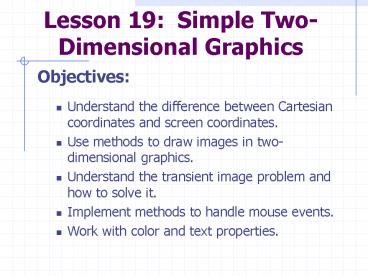Lesson 19: Simple TwoDimensional Graphics - PowerPoint PPT Presentation
1 / 20
Title:
Lesson 19: Simple TwoDimensional Graphics
Description:
In Java and most other programming languages, the coordinate ... Orientation of Java's coordinate system: 19.1 The Conceptual Framework of Computer Graphics ... – PowerPoint PPT presentation
Number of Views:68
Avg rating:3.0/5.0
Title: Lesson 19: Simple TwoDimensional Graphics
1
Lesson 19 Simple Two-Dimensional Graphics
- Objectives
- Understand the difference between Cartesian
coordinates and screen coordinates. - Use methods to draw images in two-dimensional
graphics. - Understand the transient image problem and how to
solve it. - Implement methods to handle mouse events.
- Work with color and text properties.
2
Lesson 19 Simple Two-Dimensional Graphics
- Vocabulary
- coordinate system
- c-curve
- fractal object
- fractals
- graphics context
- horizontal bar graph
- line graphs
- origin
- paint mode
- panel
- refreshable image
- screen coordinate system
- transient image problem
- vertical bar graph
- XOR mode
3
19.1 The Conceptual Framework of Computer
Graphics
- Underlying every graphics application is a
coordinate system. - Positions in this system are specified in terms
of points. - Points in a two-dimensional system have x and y
coordinates. - The x and y coordinates of a point express its
position relative to the system's origin at (0,
0). - Figure 19-1 presents some examples of points in
the familiar Cartesian coordinate system.
4
19.1 The Conceptual Framework of Computer
Graphics
5
19.1 The Conceptual Framework of Computer
Graphics
- In Java and most other programming languages, the
coordinate system is oriented as in Figure 19-2. - Note that the only quadrant shown is the one that
defines the coordinates of the computers screen.
- The other three quadrants exist, but the points
in them never appear on the screen. - This is called a screen coordinate system.
6
19.1 The Conceptual Framework of Computer
Graphics
- Orientation of Javas coordinate system
7
19.1 The Conceptual Framework of Computer
Graphics
- You can also create rectangular regions within a
window called panels. - Each panel has its own coordinate system that is
similar in form to the window's coordinate
system. - Java programmers usually draw images on panels
and almost never on the window itself.
8
19.1 The Conceptual Framework of Computer
Graphics
- The Graphics Class
- The package java.awt provides a Graphics class
for drawing in a panel. - A panel maintains an instance of this class,
called a graphics context, so that the program
can access and modify the panel's bitmap. - Some commonly used Graphics drawing methods are
listed in Table 19-1. - The table also shows the results of running these
methods in a window that has a single panel.
9
19.1 The Conceptual Framework of Computer
Graphics
10
19.1 The Conceptual Framework of Computer
Graphics
11
19.1 The Conceptual Framework of Computer
Graphics
12
19.1 The Conceptual Framework of Computer
Graphics
- There are also the methods fillArc, fillRect, and
fillOval, which draw filled shapes.
13
19.1 The Conceptual Framework of Computer
Graphics
- Adding a Panel to a Window
- BreezySwing provides the class GBPanel for
defining panels. - To write a graphics application, one should do
two things - Define a subclass of GBPanel.
- This class accesses the graphics context to
create the drawing. - The panel can draw images "on its own" or in
response to messages sent to it from the main
window - Create an instance of the panel class and add
this object to the application's window.
14
19.1 The Conceptual Framework of Computer
Graphics
- Let us assume that someone has defined a panel
class named ExamplePanel. - The following application adds an instance of
this class to a window.
15
19.1 The Conceptual Framework of Computer
Graphics
import BreezySwing. public class
GraphicsExamples extends GBFrame private
GBPanel panel public GraphicsExamples()
panel addPanel(new ExamplePanel(),
1,1,1,1) public static void main
(String args) GraphicsExamples theGUI
new GraphicsExamples() theGUI.setSize
(200, 200) theGUI.setVisible(true)
16
19.1 The Conceptual Framework of Computer
Graphics
- The form of the method for adding a panel to a
window is - More often than not, we will use code such as
- This code provides a variable of the specific
panel type so that messages can be sent to it
without casting.
ltvariable namegt addPanel(ltpanel objectgt,
ltrowgt, ltcolgt, ltwidthgt,
heightgt)
private ExamplePanel panel private GBPanel
p public SomeConstructor() panel new
ExamplePanel() p addPanel(panel,
1,1,1,1)
17
19.1 The Conceptual Framework of Computer
Graphics
- Implementing a Panel Class and the Method
paintComponent - The responsibilities of a panel class are to draw
images in response to messages from an
application and also to redraw images whenever
the window is refreshed. - When a window opens, the JVM sends the message
paintComponent to each window object. If the
object has any images to draw, its paintComponent
method accomplishes this. - Following is the code for the implementation of
the ExamplePanel class used earlier. Its
paintComponent method draws a line segment when
the window opens and whenever it is refreshed.
18
19.1 The Conceptual Framework of Computer
Graphics
import BreezySwing. // Needed for
GBPanel import java.awt. // Needed for
Graphics public class ExamplePanel extends
GBPanel public void paintComponent
(Graphics g) super.paintComponent(g)
g.drawLine(10, 25, 40, 55)
19
19.1 The Conceptual Framework of Computer
Graphics
- The method first calls the same method in the
superclass. - The reason is that the method in the superclass
paints the background of the component. - This effectively clears any images in the panel
before they are redrawn
20
19.1 The Conceptual Framework of Computer
Graphics
- The methods getWidth() and getHeight() return the
current width and height of a panel,
respectively. - The following code would maintain a display of a
panel's current width and height near the center
of the panel
public void paintComponent (Graphics g)
super.paintComponent(g) g.drawString("("
getWidth() "," getHeight() ")",
getWidth() / 2, getHeight() / 2)

